Distance Learning: A Father and Son in Spain
By Bob Kunzinger
Photos by Michael Kunzinger
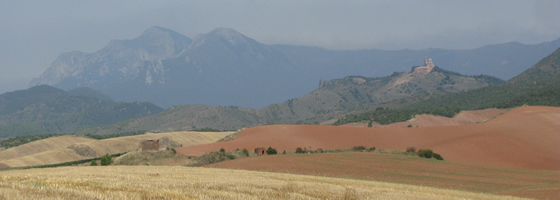
Some simple math: According to Google Maps, it takes about eight hours and fifteen minutes to drive Route A-52, the main road from St. Jean Pied du Port, France, to Santiago de Compostella, Spain, roughly five hundred miles. If you wake, have coffee and perhaps a croissant, and head out by eight, you’ll be in Santiago just after four that afternoon. Maybe a few minutes later since you would have stopped to take pictures of mountain goats in the Pyrenees.
It took my son and me about five weeks. We walked.
We had bruises, bandaged sores, and bloodied toenails. My feet grew an entire size and I lost fifteen pounds despite the rich diet and daily doses of delicious Spanish wine. We climbed trails made of nothing but rocks and descended slopes so steep blood blisters formed daily.

This is what happens on the Camino de Santiago, the third most popular pilgrimage in the Christian world, behind Rome and the Holy Land. We talked to other trekkers along the way, running into them again and again at cafes and albergues until bonds formed from sharing this medieval pilgrimage across northern Spain. Walking allowed the silence of the Pyrenees to guide us where the only sound was our walking sticks every few seconds hitting the path, or the gentle woosh of the windmills across the countryside. Some pilgrims listen to music in headphones; some are in constant conversation with companions; and everyone stops every once in a while to adjust a pack or drink water from the scattered fountains on the Camino. But mostly we walked in silence or talked about the surroundings or about the sites, like thousand-year-old chapels used by Charlemegne, saints, and kings. We walked past small farms with stone buildings and yards filled with chickens.
One thing is for certain: we wouldn’t have seen any of this if we drove it in a day. It took us roughly seven hundred and seventy hours, or about ninety-six times longer than a Sunday drive. Back home in what quickly became referred to as “the Old World,” information is instantaneous and “being there” is as easy as logging on. Artificial stimulation has become a natural process. Meetings and phone calls and explanations and disappointments are the daily routine, and the hum of civilization permeates our most private thoughts. So to wake up every morning and walk the Camino is fanatically dreamlike. We drink café con leche while talking to new friends from other lands. We put on packs and pick up walking sticks then begin the day’s leisurely stroll of fifteen or more miles past sunflower fields, vineyards, mountain ranges and medieval villages. Cervantes and Queen Isabella and Francis of Assisi are colleagues, walking this way before us. We find no reference to life at home; it is a complete abandonment of routine, despite the daily routine. It is an absolute acceptance of the here and now, where every single step is taken with purpose and awareness, where everyone we meet understands the questions, and where the biggest lesson is how little we need.
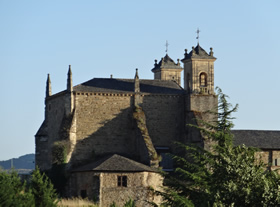
A typical trekker finds a monastery in a small village, Samos for instance, and locates a priest and pays whatever he can afford for a room and a simple meal. After dinner he probably attends a short prayer service, but it isn’t required. He might wander the grounds that night, or walk into the village, but most likely he will adhere to the monastery’s request everyone settle into the rooms by eleven. In the morning he will join the monks for mass or just leave early or wait and have some coffee and toast, perhaps some eggs and potatoes. That is pretty much the description and routine of a pilgrim from the twelfth century as detailed in the Codex Calixtinus, the first guide to the Camino written just after the first crusades; a guide which can still be used. Other than details explaining which villages have albergues and cafes and ATMs, or how far it is between places to rest, the latest guidebooks provide little more necessary information than did the first. Pilgrims a thousand years ago were welcomed with open arms and fine hospitality into monasteries and homes and small inns, since to welcome a pilgrim was to welcome St. James, or even Christ Himself, into their homes. While the pleasantry still exists when approaching an albergue for the night, the motivation is more for money than graces. Still, most of what we need to walk the Camino barely differs from what we need to travel through life: A place to stay, food, companionship, and direction. We certainly gathered conveniences through the centuries, making our stay more comfortable and communication more convenient. We’ve added varieties of food and lightened up a bit on the dishing out of penance, but when you get down to basics, the basics haven’t changed. In fact, they’ve been abandoned nearly completely, and for many pilgrims the Way is a way to find that simplicity again, discover again the most basic of realities for the walker: we don’t need much.
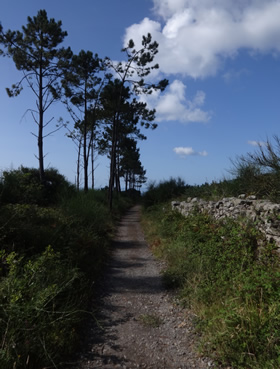
Some trekkers measure the Camino in kilometers, some in miles, some in days, and some by degree. For some the pilgrimage is a time in their life which separates how they were from how they will be from then on: merciful, penitent, and patient. For me it makes the methodic pace of predictable time more fluid and less linear. Two towns to the east and we’re sitting with Francis Javier, the great Saint of Spain, but a few days walk west and we sit with Francis of Assisi who walked this Way before us and remains mysteriously present.
Time ticks off in centuries here.
The nun who welcomes us to Saint Sebastian Church near Pamplona has replaced her sister, who replaced her sister, who replaced another, so that stopping in for bread and prayer today is no different than it was when the first bells were installed a thousand years ago.
Clearly most people walk the Camino for religious reasons, starting at home, or at Notre Dame Cathedral in Paris. Others walk for the connection to other pilgrims, both contemporary and historic. Some just like to walk. We met two men who started in Frankfort, Germany, and had already covered 2800 kilometers. I talked one afternoon to a father and son who biked from Amsterdam. St Francis began this same pilgrimage exactly eight hundred years before us in Assisi, made it to Santiago, and then walked home. In the Middle Ages, everyone had to walk home and some still do. We started in St Jean Pied de Port in France, the most traditional of the four main routes. From there the Way of St James crosses the Pyrenees, heads west at Pamplona across the meseta, and then into the mountains of Galacia to Santiago. And even after reaching the great Cathedral in Santiago, many pilgrims continue to the coast, Fisterra, the traditional “end of the world” for its status at one time thought to be the western most point in Europe. This is the last place on old maps before it was written “there be dragons” waiting. It was Fisterra that Columbus stopped before sailing west across the Atlantic that first time.
When the prisoners or the penitent or the parish priest made pilgrimage to Santiago a thousand years ago, local officials or parishioners back home wanted to know they completed the journey, so the pilgrims would bring back a scallop shell, then in great abundance at Fisterra. A thousand years later and the scallop shell still stands as proof of the pilgrimage for all peregrinos.
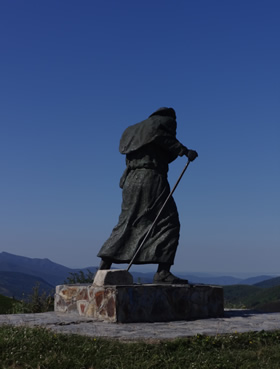
Our feet remain the most common concern of all pilgrims from the Middle Ages to today. I might have been the only peregrino on the Camino in a pair of bright green running shoes, and I am equally certain I was the only pilgrim perhaps since Saint Francis of Assisi who did most of the last hundred kilometers in flip flops; I’m not new to walking.
But here’s the thing: To walk the Camino de Santiago is to suspend all previous reference to time and distance. When you drive eight hours you look at the clock; when you walk for five weeks you forget how to tell time. At first you convert kilometers into miles until you know the length of a kilometer just by looking across a field of sunflowers. Then you forget why you wondered the time or distance to begin with, and you just walk. You stand on a ridge and in the distance you see a village, the stone steeple, the stone walls and fences which keep in chickens and which kept out armies. You see fields of steer and sheep, and you head that way for a café to cool off or caffeinate, or to sit and compare experiences in a crowded albergue, or an empty one which used to be a hospital during the plague eight hundred years ago. Now it’s a restaurant and a place to stay. You forget what day of the week it is, and if you haven’t yet abandoned the guidebook, you look up information you already know simply by repeating it every day. You only pay attention to this day’s stretch of land or the valley to the south where millenium old monasteries serve wine and welcome pilgrims without charge. You are in that rarest of all experiences, completely and without compromise in the moment, each moment, and only that moment, for five straight weeks.
The Camino de Santiago is the perfect example of a journey whose destination is reached every single café, chapel and fountain along the way. At the end of the first day’s twenty-four mile trek across the Pyrenees we arrived at the albergue in Roncevalles, Spain. We sat on stools in the basement café having a celebratory drink and talked to the owner about the day and America and Spain and food. That one day alone—called the hardest of the journey, the first—was an entire journey in itself, and we had just started. In very little time I realized every day was in its own way a pilgrimage. Each conversation and each moment of silence was a pilgrimage. We stayed up and talked most of the night to the man behind the bar who must spend his life having conversations just like ours.
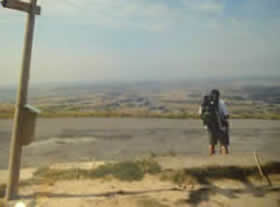
But despite the companionship, every one of us follows some road not taken, finding solitude among the masses. “Inscape,” Thomas Merton called it, and for me by doing so I discovered something so lacking in my life I did not yet know how to understand it: Simplicity. Everything I needed fit comfortably in my backpack with plenty of room to spare. I was never in want, though at home surrounded by comparative riches and supplies, there was never enough. It is fascinating to discover how much we already have when put to the task of redefining “needs.”
I spent most of the five weeks unpacking my burdens, my lack of faith, my sense of self, my understanding of community. I learned while walking through the mountains of Basque country the flexibility of an hour and the indecisiveness of a mile. By the time we walked up the mountainside into Galacia around the pastures of grazing sheep and the vistas of western Spain, I accepted the truth that my life, which I so sought to control, was out of my hands and could only be mine again by letting go.
About the author
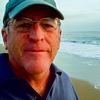
Bob Kunzinger is a non-fiction writer in Virginia. His work has appeared in numerous publications and has been noted several times by Best American Essays. He is at work on a book about Siberia and one about walking across Spain. Visit his blog: a view from this wilderness.
Did you like the article? Subscribe here to our New Article Email Alert or RSS feeds.
Sharing is caring! Don't forget to share the love, and keep the conversation going by leaving a comment below:
Advertisement
